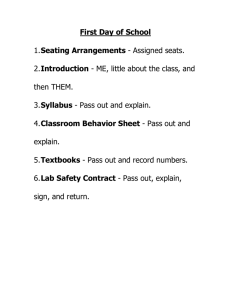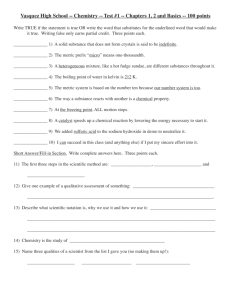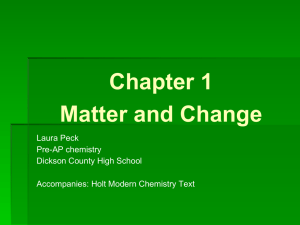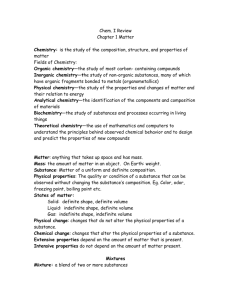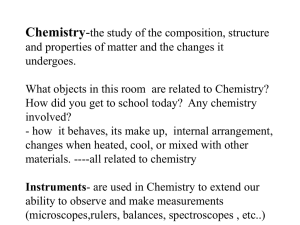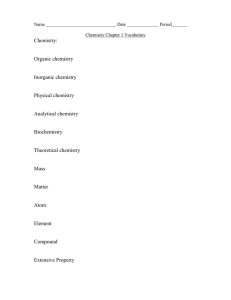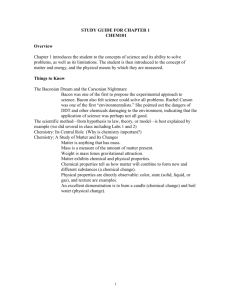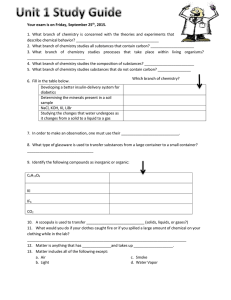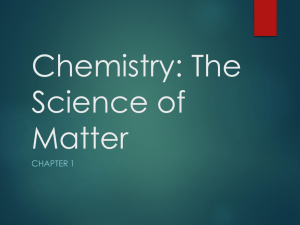First Day of School Seating Arrangements Introduction
advertisement
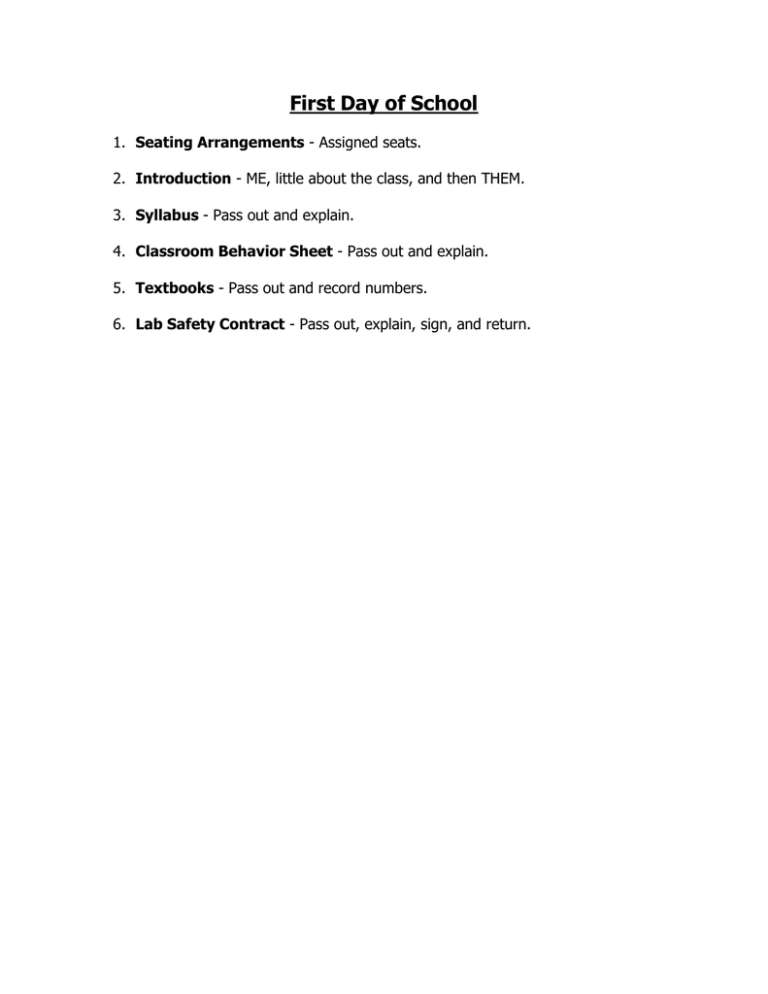
First Day of School 1. Seating Arrangements - Assigned seats. 2. Introduction - ME, little about the class, and then THEM. 3. Syllabus - Pass out and explain. 4. Classroom Behavior Sheet - Pass out and explain. 5. Textbooks - Pass out and record numbers. 6. Lab Safety Contract - Pass out, explain, sign, and return. Chapter 1: Matter and Change *Note - Lab safety and equipment will be tested with this chapter! I. Lab Safety and Equipment. A. Lab safety has been discussed already. BE SAFE!! B. Lab equipment-students are responsible for all lab equipment on handout that was given out. (utility clamp, iron ring, buret clamp, clay triangle, wire gauze, burner, ring stand, triple beam balance, electronic balance, pipet, buret, forceps, triangular file, test tube brush, striker, test tube rack, test tube, beaker, funnel, volumetric flask, Erlenmeyer flask, wash bottle, graduated cylinder, test tube holder, watch glass, evaporating dish, crucible and cover, rubber stoppers, safety goggles, crucible tongs, and beaker tongs.) C. Students will not be able to participate in lab until a lab quiz is passed (95%). II. Chemistry Is a Physical Science A. Chemistry - The study of the composition, structure, and properties of matter, the processes that matter undergoes, and the energy changes accompany these processes. B. There are many different branches of Chemistry. We break things down into 6 different branches, which sometimes overlap. 1. Organic Chemistry - Study of most carbon containing compounds. 2. Inorganic Chemistry - Study of all substances not classified as organic, mainly compounds that do not contain carbon. 3. Physical Chemistry - Study of the properties and changes of matter and their relationship to energy. 4. Analytical Chemistry - Identification of the components and the composition of materials. 5. Biochemistry - Study of substances and processes occurring in living things. 6. Theoretical Chemistry - Use of math and computers to understand the principles behind observed chemical behavior and to design and predict the properties of new compounds. 7. Chemists work with chemicals. A chemical is any substance that has a definite composition, for example: water, CO2, and glucose. C. Chemistry is also used in research and development. 1. Basic Research - conducted for the sake of knowledge only and not to meet practical goals. (We will use basic research in lab.) 2. Applied Research - conducted to solve problems or fulfill specific needs. (For example: O3 layer damage, pharmaceutical research.) 3. Technological Development - production and use of products that improve our quality of life. (For example: computers, catalytic converters, and biodegradable materials.) III. Matter and Its Properties A. What is matter? 1. Matter - anything that has mass and takes up space. 2. Mass - measure of the amount of matter. Measured using a balance. B. Building Blocks of Matter 1. The fundamental building blocks of matter are atoms. An atom is the smallest unit of an element that maintains the properties of that element. 2. An element is a pure substance made only of one kind of atom. 3. A compound is a substance that is made from the atoms of two or more elements that are chemically bonded. C. Properties and Changes in Matter: 1. A physical property is a characteristic that can be observed or measured without changing the identity of the substance. (For example: melting point and boiling point.) 2. A physical change is one that does not involve a change in the identity of the substance. (For example: phase changes, grinding, and cutting.) 3. 4 states of matter: a. solid - definite volume and shape. (Ex. Ice) b. liquid - definite volume, no definite shape. (Ex. Water) c. gas - no definite volume, no definite shape. (Ex. Water vapor) d. plasma – high temperature physical state of matter in which atoms lose most of their electrons. This is not the same as the plasma in your blood. (Ex. Sun, fluorescent bulbs, lightning) 4. A chemical property relates to a substance’s ability to undergo changes that transform it into different substances. (For example: flammability, reactivity, ability to …) 5. A chemical change is a change in which one or more substances are converted into different substances, this is also called a chemical reaction. (For example: burning, rusting, tarnishing.) 6. 7. The substances that react in a chemical change are called reactants. The substances that are formed by the chemical change are called products. When physical and chemical changes take place energy is involved. It is absorbed and released, but NEVER created nor destroyed. This is the Law of Conservation of Energy. IV. Classification of Matter: A. Matter can be classified using a flow chart. Before we can construct this flow chart, we have to define several terms. 1. Mixture - a blend of two or more kinds of matter, each of which retains its own identity and properties. There are two types. a. Homogeneous Mixture - uniform in composition. You cannot tell the difference between the different parts. Also called solutions. b. Heterogeneous Mixture - not uniform throughout. You can tell the difference between the different parts. 2. Pure Substance - has a fixed composition and differs from a mixture in two ways: a. Every sample of a pure substance has exactly the same characteristic properties. b. Every sample of a pure substance has exactly the same composition. c. Pure substances can be either elements or compounds. 3. Complete flow chart for matter classification. B. All lab chemicals have a degree of impurity. We have to assume that they do not. The impurity of each chemical is listed on the bottle. V. Elements. A. Introduction to the Periodic Table 1. Symbols are often based on the English names of the elements. 2. Some are derived from the elements come from older names, usually Latin. See Table 2 on page 16. 3. Family(Group): vertical columns of elements. Contain elements with similar chemical properties. For example, the Noble Gases are in group 8A. They are generally unreactive. All are gases at room temperature. 4. Periods: horizontal rows of elements. B. There are three types of elements. 1. 2. 3. Metal - an element that is a good conductor of heat and electricity. Most are solids at room temperature. Nonmetal - an element that is a poor conductor of heat and electricity. Many are gases at room temperature. Metalloid (Semimetal) - an element that has some characteristics of metals and some characteristics of nonmetals. All are solids at room temperature.
